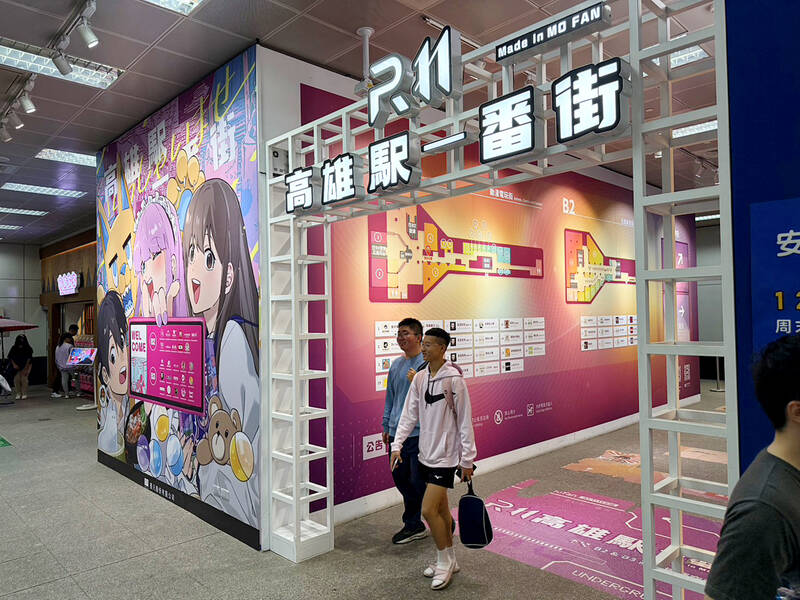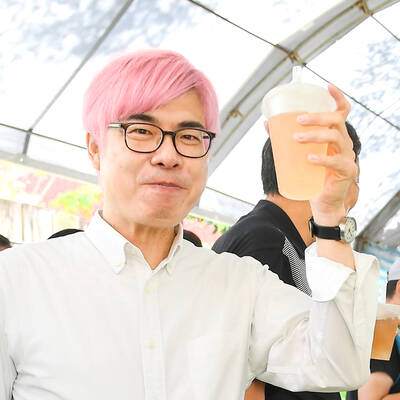It’s an enormous dome of colorful glass, something between the Sistine Chapel and a Marc Chagall fresco. And yet, it’s just a subway station.
Formosa Boulevard is the heart of Kaohsiung’s mass transit system. In metro terms, it’s modest: the only transfer station in a network with just two lines.
But it’s a landmark nonetheless: a civic space that serves as much more than a point of transit.

Photo: Julien Oeuillet
On a hot Sunday, the corridors and vast halls are filled with a market selling everything from second-hand clothes to toys and house decorations.
It’s just one of the many events the station hosts, alongside exhibitions, cosplay conventions and even small concerts — all staged under the stunning glass dome.
Kaohsiung has done something rare: built a modern MRT system that’s more than a subway: it’s a cultural institution.

Photo: Julien Oeuillet
This didn’t happen in a vacuum. Kaohsiung was long a harbor city, industrial and working class in character.
Scooters have always ruled the roads, a practical and cheap way to zip through the city while beating the heat.
So when the Kaohsiung Rapid Transit system (KRT) broke ground in 2001, many doubted locals would use it.
But since its launch in 2008, the KRT — and now its companion Light Rail Transit (LRT) — has become a cornerstone of the city’s identity.
KRT GIRLS AND MIKAN THE CAT
The ceiling of Formosa Boulevard helped win hearts, but the KRT had another trick up its sleeve: the KRT Girls. This quartet of anime-style mascots, inspired by similar characters used in Japanese transit, became the friendly faces of the system.
On signs, they welcome passengers stations and coaches, or remind them to pay fares.
Thanks to these characters, “we can do all promotions ourselves,” says Caroline Chang (張珏瑋), manager of public affairs department of the KRT Corporation, “we don’t need to pay idols, they are always available for whatever we want them to do.”
These mascots created parasocial bonds between commuters and the system. This became even more vivid with the arrival of another mascot: Mikan the cat.
“He was just a stray cat before” Chang says, “he lived in a station and he was so popular that the crowd clogged corridors, so we brought him to our office.”
Now, Mikan has his own Instagram, appears at events and his cartoon likeness decorates station walls.
“Mikan has souvenir stores, audience meetups,” says Chang, “he is very famous now, and even [former] president [Tsai Ing-wen, 蔡英文] visited him.”
When the LRT opened, the same marketing ploy as adopted — a cartoon dolphin and two LRT girls were added to the cast.
“They are like family to us” Chang says.
Kaohsiung turned public transit into a theme park — in the best sense.
The transformation extended beyond signage. Stations became destinations.
The two largest — Formosa Boulevard and Kaohsiung Train Station — now host “MoFan” malls, inaugurated in 2022.
Unlike the scattered retail corners common in metro systems elsewhere, these spaces were designed to be real malls: venues for social life, dining and shopping. A place to hang out, not just pass through.
A local recalls how a couple years ago she found a restaurant online that seemed good, and was amazed when she discovered it was located inside the station: she had assumed it was an empty space.
Now, locals know better. And outsiders are still discovering it.
As an official from MoFan says, “you can’t build this culture overnight, you must learn the lifeststyle of local people.”
LESSONS
And this is what makes the KRT system interesting: it is full of lessons for other cities.
From the outside, Kaohsiung might seem a provincial city — small by East Asian standards, dwarfed by regional megacities.
But it built a public transit that other cities, even capital cities, could learn from: a metro that was accepted by its citizens, embraced by its culture and turned into a public symbol.
As the market winds down that Sunday afternoon, people wander out of Formosa Boulevard with bags of handmade goods or linger for a bite to eat. Some came to take the train. But many came just to be here. The subway station itself has become the destination.

The Taipei Times last week reported that the rising share of seniors in the population is reshaping the nation’s housing markets. According to data from the Ministry of the Interior, about 850,000 residences were occupied by elderly people in the first quarter, including 655,000 that housed only one resident. H&B Realty chief researcher Jessica Hsu (徐佳馨), quoted in the article, said that there is rising demand for elderly-friendly housing, including units with elevators, barrier-free layouts and proximity to healthcare services. Hsu and others cited in the article highlighted the changing family residential dynamics, as children no longer live with parents,

It is jarring how differently Taiwan’s politics is portrayed in the international press compared to the local Chinese-language press. Viewed from abroad, Taiwan is seen as a geopolitical hotspot, or “The Most Dangerous Place on Earth,” as the Economist once blazoned across their cover. Meanwhile, tasked with facing down those existential threats, Taiwan’s leaders are dying their hair pink. These include former president Tsai Ing-wen (蔡英文), Vice President Hsiao Bi-khim (蕭美琴) and Kaohsiung Mayor Chen Chi-mai (陳其邁), among others. They are demonstrating what big fans they are of South Korean K-pop sensations Blackpink ahead of their concerts this weekend in Kaohsiung.

Taiwan is one of the world’s greatest per-capita consumers of seafood. Whereas the average human is thought to eat around 20kg of seafood per year, each Taiwanese gets through 27kg to 35kg of ocean delicacies annually, depending on which source you find most credible. Given the ubiquity of dishes like oyster omelet (蚵仔煎) and milkfish soup (虱目魚湯), the higher estimate may well be correct. By global standards, let alone local consumption patterns, I’m not much of a seafood fan. It’s not just a matter of taste, although that’s part of it. What I’ve read about the environmental impact of the

Oct 20 to Oct 26 After a day of fighting, the Japanese Army’s Second Division was resting when a curious delegation of two Scotsmen and 19 Taiwanese approached their camp. It was Oct. 20, 1895, and the troops had reached Taiye Village (太爺庄) in today’s Hunei District (湖內), Kaohsiung, just 10km away from their final target of Tainan. Led by Presbyterian missionaries Thomas Barclay and Duncan Ferguson, the group informed the Japanese that resistance leader Liu Yung-fu (劉永福) had fled to China the previous night, leaving his Black Flag Army fighters behind and the city in chaos. On behalf of the